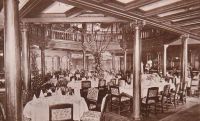|
| c1907/08 - 1914 |
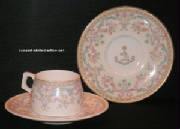
|
| Floral Pastel - Lusitania |
Here is the second variation of the Floral Pastel pattern which is more
commonly found in collections. While it is not known when these pieces were put into production (speculated 1907/08), they
were used only up until around 1914. This pattern is more clean-cut and is stunning with its pastel colors and gold rim, backmarked
Mintons, England. These were used onboard the Lusitania and Mauretania's first class areas and other
items can be viewed under the RMS Mauretania 1st Class China page. One of the most beautiful patterns made and harder
to find than WSL china! This pattern was also used on souvenir dishes with paintings of these liners in the center, marked
'Souvenir' on the bottom. If it does not have souvenir, then it was a piece from the regular onboard service.
| 1913 - 1920s |
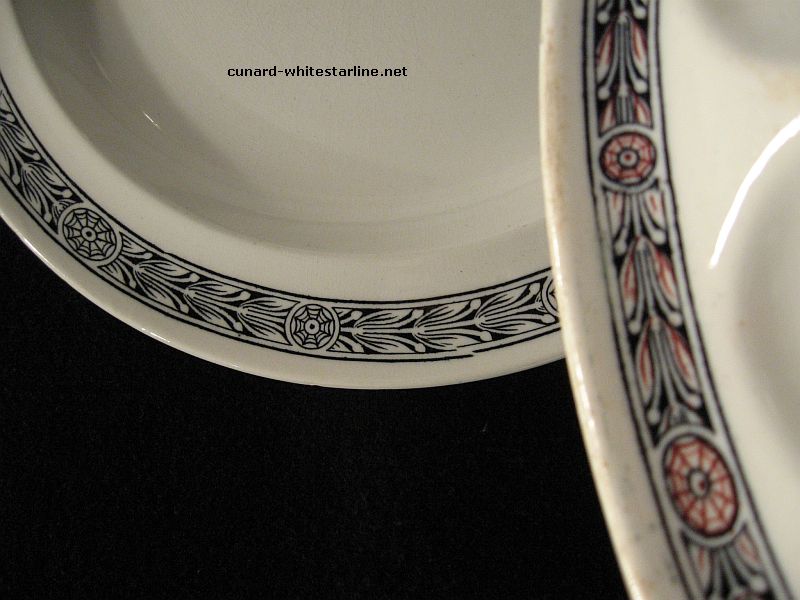
|
| Spiderweb |
This is one of the more obscure patterns used by Cunard - the spiderweb
china. This pattern was introduced in 1914 and replaced the Floral Pastel china onboard the Lucy and Maury while
making its debut onboard Cunard's new RMS Aquitania. This pattern has been recovered from the wreck of the Lusitania
when she sank in 1915. Our oval dish is dated 1913, and the dinner plate is missing the last of the 3-piece code
for the year. There is another letter placed opposite the logo, which if infact is the missing letter, would date the plate
to 1913 as well. There are two variations, one pattern in black & white, while the other has a red overlay between
the pattern. Backmarked: Wedgwood, Etruria, England. Examples of
this pattern can be seen in book "RMS Lusitania: The Ship & Her Records."
| 1920s - 30s |
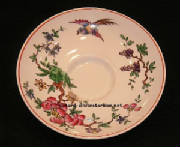
|
| Birds of Paradise |
| 1920s - 30s |
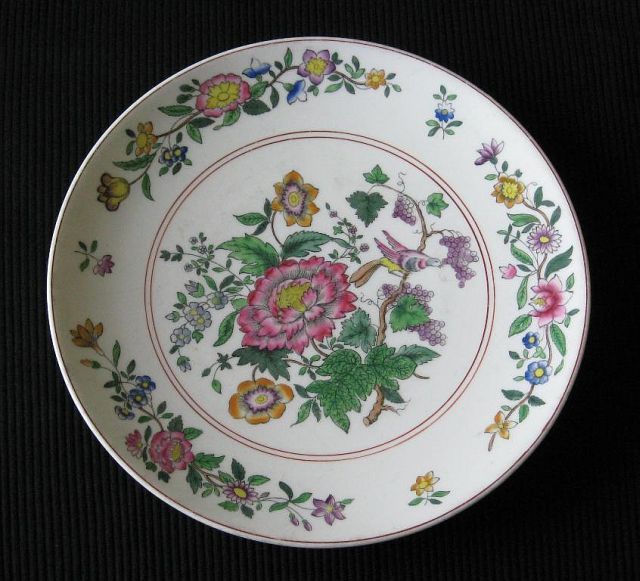
|
| Currants |
This is Cunard's Tuscan china sporting the Birds of Paradise pattern as
used onboard the RMS Aquitania. While several books have photos of this china from the ship, I have not seen it in
use on any other liner. Made in the 1920s and likely 30s, Cunard had so many people stealing this from the dining rooms that
they made souvenir china in this pattern to sell onboard. Both pieces in this exhibit are souvenir. Each piece has
a main bird on the china and an oriental look throughout - similar to the Vignette Chinese or Chinois china of the Italia
Line. Cunard also has a rare china pattern called 'Currants', which sports near identical flowers in the center and surrounding
with a bird in the center. This pattern can be easily spotted by it's back mark which is made by Copeland's Spode. The "Currants"
pattern has a very long history with Spode. The pattern first appears in Spode records as pattern #3858 around the year
1825. The pattern became known as both "Mulberry" and "Currants", and had quite a few variations in both shape and color over
the years. Most recently, the pattern was released by Spode as "Mulberry" from 1977 - 1985. It was used in first class
and is harder to find than the Birds of Paradise. This plate is dated July 1924. It is also marked with the
Copeland Spode pattern number, R4535. Note that this is Copeland's own pattern number, not the "Rd" or registration
number. Photo and description of Currants pattern by Jason Schleisman.
| 1920s - 30s |
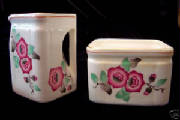
|
| Rose |
This is an example of the Rose pattern china also used onboard liners like
the Aquitania during the 1920s and 30s. There isn't much information about where this and the Birds of Paradise pattern
was used during its service, but one can speculate that the above pattern was for first class and the rose pattern was
for the second class passengers. The Birds of Paradise has an entire dinner setting and I have not seen dinnerware in this
pattern to date, just a few pieces in the form of creamers, sugar bowls, or teapots. As far as is known, none of
the Rose pattern china was made to be souvenir china - just onboard service.
| 1920s - 30s |
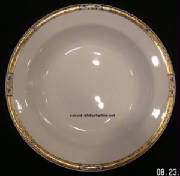
|
| Gold Greek Key |
This pattern by Booths Ltd doesn't have any specific pattern name, but
is listed as Gold Greek Key because of similarities to the regular Greek Key pattern. This pattern is on pre-war china
and was used onboard liners like the Carinthia. Very little is known about which class this was used in or if any
other china complemented the set. Of the pieces in this pattern, only soup bowls and tea cups & saucers have been
seen to date. The rim is solid gold except where there are four breaks with gold flowers and black vines are intertwined throughout.
On the teacup saucer, there is just a gold band around the outer edge with the main pattern around the tea cup rim. Backmark
has the standard Cunard Steamship Belt Logo with Booths Ltd, Silicon China, England, Patent No. 14095. There are also a few
pieces of a color version of this pattern in which the flowers are pink and yellow with a light blue band replacing the gold.
| 1920s - 60s |
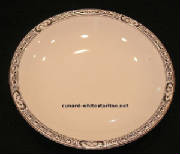
|
| Greek Key |
This Greek Key china comes in two variations - four or five sets of breaks
in the black on white pattern. According to Brian Hawley, in the 1920s, the patterns with the 4-break gold band on the rim
were used in the first class areas of the Mauretania, Aquitania, and Berengaria. After 1936, the
same pattern with the 5-break without the gold rim was used onboard the Queens in their Tourist Class up until the
1960s. To coincide with that though, the example in our collection is a 5-break plate with a gold band
on the rim and is backdated 1949. The Cunard Steamship Company Limited logo on the backside is in a plain circle with Rigway
Potteries Limited, England.
| 1930s |
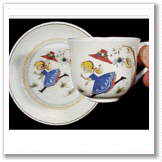
|
| Nursery Rhyme |
Here is another rare item from the tables of Cunard Line. This Nursery
Rhyme or Miss Muffet pattern china was made specifically for the Children's Room onboard the Queen Mary and Queen
Elizabeth in the 1930s. Later in the 1960s, Cunard brought about
another set of what looks like childrens china with various paintings on the front with a yellow background. I also understand
that this china may have been part of a regular service set. I do not have a photo of the later china listed here, but it
came in a few different shapes and sizes. It was said to have been used onboard liners like the Carmania and Franconia.
Photo courtesy of CabinClass.com. (Pattern Archive, Steamship China Patterns, Cunard.)
| 1936 - c1950s |
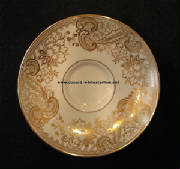
|
| Royalty |
This is an example of the rarest china pattern used by Cunard in recent
times... a piece of Cunard WhiteStar's gold "Royalty" china. This pattern was specifically designed to be used onboard
the Queen Mary and Queen Elizabeth in their few private suites starting in 1936. It became known as "royalty"
china since VIP passengers, which often turned out to be royal family members, were the only ones to use it. Because it was
never used outside these suites, very few pieces were produced, and even fewer surface on the market. It was discontinued
after brief use due to its cost to produce. There is a photo on the CunardWhiteStar page of this china in use on
the Queen Mary from Anne Anderson's book 'The Teapot Cube.' Backmarked 'Tuscan China Metallised, CunardWhiteStar,
Stoniers, Liverpool, 4493A.'
| 1930s - 60s |
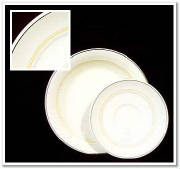
|
| Foley / Grosvenor |
Early on, Cunard used Copeland's Grosvenor pattern china onboard the Queens,
then switched to the Foley pattern seen here. Both patterns were the same, but under different names. Also called "Ivory
Ware", it was used onboard the Queens and the Caronia up until around 1968. This pattern consists of a cream
base color with a black line on the rim, two orange lines close together and a light grey line at the bottom of
the piece. Dinnerware was of typical style and the tea sets were done in a cube style. The tourist class onboard the liners
used the same shapes of dinnerware, but were all white in color and were manufactured by J. Sadler & Sons Ltd. Also not
pictured are the Foley seashell china pieces used to hold nuts, butter, or lemon wedges. These were of plain white fan-shell
design with gold rims and two small gold design on the handle. Photo courtesy of CabinClass.com (Pattern Archive, Steamship
China Patterns, Cunard.)
| 1930s - 60s |
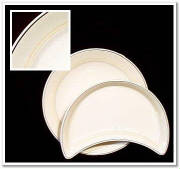
|
| Maddock |
Here are some examples of Maddox china, which was used by Cunard to go
along with its Foley line of china onboard the Queens and other ships. The two patterns only differ in that the Maddox
china is based on tan china rather than cream, and the two orange lines on Maddox china are spaced further apart. These pieces
were used in first and cabin class areas onboard. For souvenir china, George Clewes manufactured the same basic teapot sets
in all brown or faded brown with souvenir marked on the backside - No Photo. Of all the Cunard Line china, this is the easiest
to obtain and is relatively inexpensive. Photo courtesy of CabinClass.com. (Pattern Archive, Steamship China Patterns, Cunard.)
| 1968 - 70s |
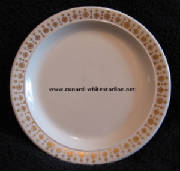
|
| Snowflake |
This is Cunard's Snowflake pattern created for the 1970s onboard service
of the Queen Elizabeth 2. Done in a metallic gold against white, this was made by Ridgway and it believed to have
been exclusive to the Queen Elizabeth 2. Although it has been created specifically for the newly-launched liner,
it is not clear whether it was used on any others. Aside from the normal service china, 5 inch casserole dishes were also
made in this pattern. Backmarked: Ridgway Steelite, Vitreous China Hotel Ware, England, Regd. Trademark 738990, Cunard.
| 1970s - 2008 |
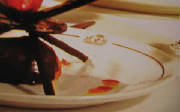
|
| Gold Band & Logo |
This is the modern Cunard china pattern with a simple gold line and the
Cunard lion & crown with fern leaves on one side of the plate. This pattern is commonly used on Cunarders - namely the
Queen Elizabeth 2. The pattern was introduced for onboard service in the 1970s. These pieces are coming
more into demand due to the retiring of the QE2 in 2008. Courtesy: 2007 Cunard Line Brochure. Used with permission
of the Cunard Line Limited.
| 1990s - Retirement |
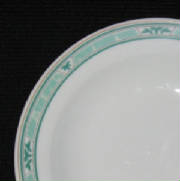
|
| Lido Deck China |
This photo is of a bowl from the Queen Elizabeth 2 and it is the last pattern officially used in the
QE2's Lido Restaurant. The bowl was made by Porsgrund in Norway. It disembarked the ship with a man who discovered
that the bowl had somehow managed to fall into his suitcase during the QE2's Last Transatlantic Crossing. Photo and description
by Jason Schleisman.
| 2004 - Present |
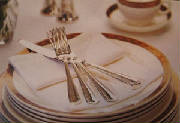
|
| Queen Mary 2 |
When the Queen Mary 2 was launched in 2004, Wedgwood produced
a beautiful pattern exclusively for the new liner. While this pattern has no given name, it consists of fine white bone china
and deeper green band around the rim. Within the green band is an interlocking chain pattern alternating between the deep
green and delicate gold links. A beautiful pattern which no one has apparently managed to smuggle off the ship yet. I hope
in a few years time, CWSL will be able to add the current Cunard china production to our collection. Courtesy: 2007 Cunard
Line Brochure. Used with permission from the Cunard Line Limited.
| 2004 - Present |

|
| Todd English |
This pattern of china is used onboard the Queen Mary 2 in the
Todd English Restaurant, which serves Mediterranean specialities while overlooking the Pool Terrace. This china is reminiscent
of the Queen Elizabeth 2's snowflake china as it is white square dinner plates with gold dots around the borders.
The side plates used with these pieces are of plain white design. Courtesy: 2008 Cunard Line Brochure. Used with permission
of the Cunard Line Limited.
| December 2007 |
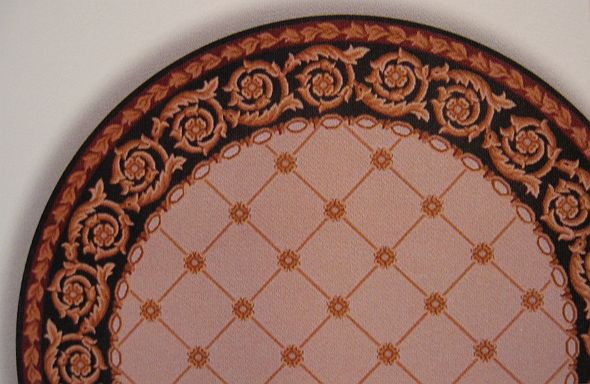
|
This is the beautiful new china pattern which is used onboard the
newest ocean liner of the Cunard fleet - the Queen Victoria. Harkening back to an age of beautiful and rich patterns,
it will most likely be used in the Queens Grill... an exclusive class onboard this amazing ship. Sometime we hope to gain
an example of each of these beautiful new patterns. Courtesy: 2008 Cunard Line Brochure. Used with permission of the Cunard
Line Limited.
|
